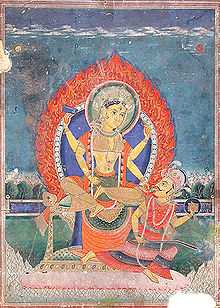Bagalamukhi
| Bagalamukhi | |
|---|---|
| Standstill or Who can take control over enemies physical and mental action. | |
 | |
| Affiliation | Mahavidya |
| Mantra | Om hlreem baglamukhi sarvadustanaam vacham mukham padam stambhaya jihvaam keelaya budheem vinashaya hlreem om swaha |
| Weapon | Cudgel |
| Mount | Corpse or Ghost. |
Bagalamukhi or Bagala (Devnagari: बगलामुखी) is one of the ten mahavidyas (great wisdom goddesses) in Hinduism. Bagalamukhi Devi smashes the devotee's misconceptions and delusions (or the devotee's enemies) with her cudgel. She is also known as Pitambara Maa in North India.
Since the Mahavidyas are independently-existing Goddesses, they exist devoid of male counterparts. They are said to be existent without a 'consort' (or the Purusha, like the other forms of Shakti are often identified in the Tantric texts as the energy of a male deity, primarily, Lord Shiva). Thus, Bagalamukhi too is one of the ten forms of the wisdom goddesses, symbolising the potent female primeval force by Her own will.
Iconography
"Bagalamukhi" is derived from "Bagala" (distortion of the original Sanskrit root "valgā") and "mukha", meaning "bridle" and "face", respectively. Thus, the name means one whose face has the power to capture or control. She thus represents the hypnotic power of the Goddess.[1] Another interpretation translates her name as “crane faced”.
Bagalamukhi has a golden complexion and her dress is yellow. She sits in a golden throne in the midst of an ocean of nectar full of yellow lotuses. A crescent moon adorns her head. Two descriptions of the goddess are found in various texts- The Dwi-Bhuja (two handed), and the Chaturbhuja (Four handed).
The Dwi-Bhuja depiction is the more common, and is described as the Soumya or milder form. She holds a club in her right hand with which she beats a demon, while pulling his tongue out with her left hand. This image is sometimes interpreted as an exhibition of stambhana, the power to stun or paralyse an enemy into silence. This is one of the boons for which Bagalamukhi’s devotees worship her. Other Mahavidya goddesses are also said to represent similar powers useful for defeating enemies, to be invoked by their worshippers through various rituals.
Bagalamukhi is also called Pitambaradevi or Brahmastra Roopini and she turns each thing into its opposite. She turns speech into silence, knowledge into ignorance, power into impotence, defeat into victory. She represents the knowledge whereby each thing must in time become its opposite. As the still point between dualities she allows us to master them. To see the failure hidden in success, the death hidden in life, or the joy hidden in sorrow are ways of contacting her reality. Bagalamukhi is the secret presence of the opposite wherein each thing is dissolved back into the Unborn and the Uncreated.
Legend
Once upon a time, a huge storm erupted over the Earth. As it threatened to destroy whole of the creation, all the gods assembled in the Saurashtra region. Goddess Bagalamukhi emerged from the 'Haridra Sarovara', and appeased by the prayers of the gods, calmed down the storm. You can see replica of 'Haridra Sarovara', as described in scriptures, at Peetambara Peetham, Datia, Madhya Pradesh, India.
Worship
Kamakhya Temple in Guwahati is considered to be the center of Tantricism, where there is the presence of temples dedicted to the ten Mahavidyas. A few miles away from the Kamakhya Temple is the temple dedicated to the Goddess Bagalamukhi. Major temples to the goddess are situated in the Bankhandi Himachal Pradesh in the north, and at Nalkheda at Agar Malwa district in Madhya Pradesh and Pitambara Peeth in Datia Madhya Pradesh. In South India there is a temple at Kallidaikurichi, Papankulam village in Tirunelveli district in Tamil Nadu.[2]
Nepal, where the worship of tantric goddesses had Royal patronage, also has a large temple devoted to Bagalamukhi in the Newar city of Patan in Nepal near Kathmandu. The territory of the Bagalamukhi temple in Patan also has several other temples dedicated to Ganesha, Shiva, Saraswati, Guheswar, Bhairava etc. The main difference between any other temple and a Bagalamukhi temple is that if someone worships all the gods in this temple, they would actually worship all 330 million gods and goddesses at one place.
See also
References
Bibliography
- David R. Kinsley (1998). Tantric Visions of the Divine Feminine: The Ten Mahāvidyās. Motilal Banarsidass Publ. pp. 196–207. ISBN 978-81-208-1522-3.
- David R. Kinsley (1988). Hindu Goddesses: Visions of the Divine Feminine in the Hindu Religious Tradition. University of California Press. pp. 161–164. ISBN 978-0-520-90883-3.
- David Frawley (1996). Tantric Yoga and the Wisdom Goddesses: Spiritual Secrets of Ayurveda. Motilal Banarsidass Publ. pp. 130–135. ISBN 978-81-208-1357-1.
External links
| Wikimedia Commons has media related to Bagalamukhi. |
| |||||||||||||||||||||||||
| |||||||||||||||||||||

